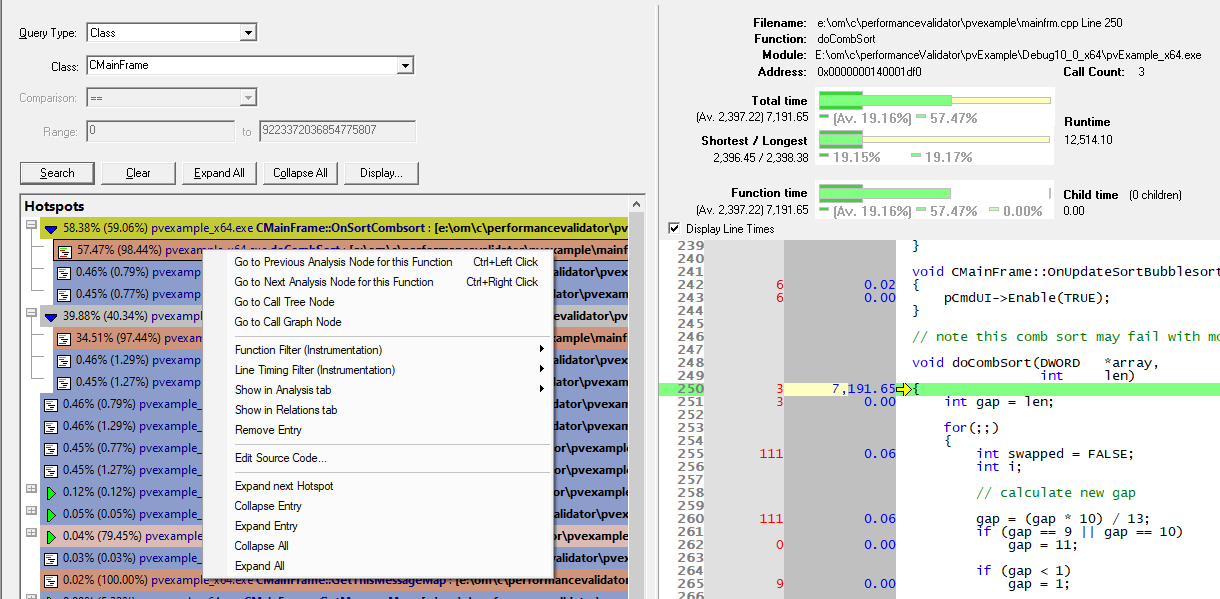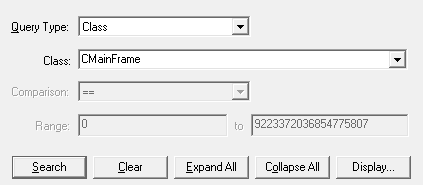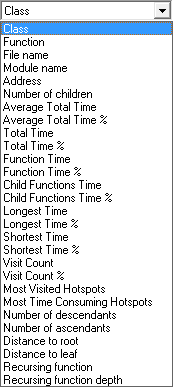The Analysis tab performs queries on the collected performance data and displays the results.
 Read on, or click a part of the image below to jump straight to the help for that area.
Read on, or click a part of the image below to jump straight to the help for that area.
As with many of the tab views, the display is split into two resizable panes.
•the left side shows a query form and an ordered hierarchical view of the matching functions called in the program's execution
The result tree's popup menu provides options to filter data or to examine it in more detail
•The right side shows the source code view for any function selected on the left
The Query form
The analysis query form lets you search the collected data and the performance statistics for a wide set of criteria.
Setting up the Query Type
•Query Type  choose the main feature on which you want to search
choose the main feature on which you want to search
There are a wide range of options and they fall into four categories:
•Function information like class, function or file name
•Performance data like total time, average time or visit count
•Hotspot queries like most visited or most time consuming
•Callstack investigation like callstack length, or recursion
The full list:
Most of these types are self explanatory or described briefly in the Statistics data but there's a few new ones:
Distance to root / leaf  find function calls at a certain nesting level from the top or the lowest point of the callstack
find function calls at a certain nesting level from the top or the lowest point of the callstack
Recursing function  find any functions that have been called recursively
find any functions that have been called recursively
Recursing function depth  find functions called recursively to a specific depth
find functions called recursively to a specific depth
The options underneath the Query Type may change to one of the following to match the corresponding type of query:
•Class, Function, File or Module  choose from the drop down list the name you want to search for
choose from the drop down list the name you want to search for
The drop down is populated with known options from the hook data.
This option is disabled if the query type doesn't require a subsequent choice of name.
Constraining the results
The results may be constrained by type of comparison with optional range checking.
For function information like class, name, file, these constraints do not apply.
For number based queries, including Address, you can limit, invert or box the results
•Comparison  choose from the comparison type from the drop down list
choose from the comparison type from the drop down list
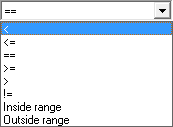
•Range  enter one or both values to specify a limit or a range, depending on the comparison type
enter one or both values to specify a limit or a range, depending on the comparison type
For example:
< (less than) or == (equals) would need just the one limit.
Inside range would need lower and upper bounds specified.
The analysis results view
Query results are shown as an ordered list of trees for every matched function that has been hooked and called.
For example, if there are 10 matching results, there will be 10 top level nodes in the tree. Some of these may show child functions, some may not.
The query result structure can be likened to taking the Call Tree data, removing all functions above a matching functions, while keeping all functions below.
Each result is shown independently of any other, so it's quite likely that some later results may also appear as children of earlier results in the list.
Functions are initially ordered by Total Time - the time a function and it's child functions contribute to the total run time.
Selecting a function shows its source code on the right hand pane.
Double clicking any item will display the function on the Relations tab.
 Like the Call Tree view, function timings shown here are for the time spent in the relevant part of the call tree, not a combined total for everywhere that a function may be used.
Like the Call Tree view, function timings shown here are for the time spent in the relevant part of the call tree, not a combined total for everywhere that a function may be used.
This example shows part of the results when searching for all functions in the class CMainFrame using the example application.
Example:
The results below show the first 5 most time consuming results when searching for functions in the class CMainFrame using the example application.

Expanding the nodes shows that results 3 and 4 above can be found within the children of the first result
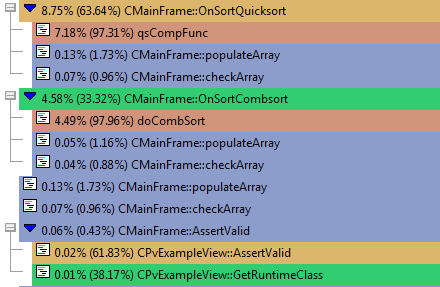
Analysis result colours
The query result tree is coloured using the customisable Hotspot Colours settings that range from 100% down to 0%.

•Colours  choose the way the colour scheme is applied in the tree
choose the way the colour scheme is applied in the tree
•Parent %  colouring is based on function time relative to that of its parent's function time
colouring is based on function time relative to that of its parent's function time
In the example below:
qsCompFunc is in the 90-100% colour band as it contributed 97.31% of its parent's function time
doCombSort is in the 90-100% colour band as it contributed 97.96% of its parent's function time
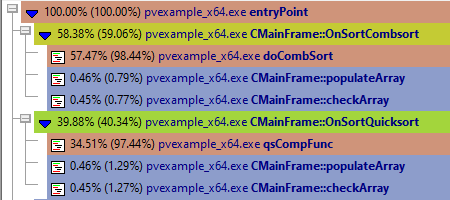
•Total %  colouring is based on function time relative to the total execution time
colouring is based on function time relative to the total execution time
Now in the example:
qsCompFunc is in the 50-60% colour band as it contributed 51.29% to the total run time
doCombSort is in the 30-40% colour band as it contributed 32.06% to the total run time
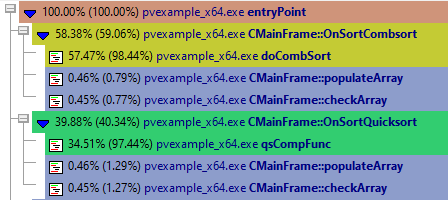
•No Colour  black and white display only
black and white display only
Updating the display
On other tabs, it's the Refresh button that updates the display. Here, although the Search button triggers the query again, it essentially does the same thing.
•Search  updates the display with the search results - as does the
updates the display with the search results - as does the  button on the Tools menu and toolbar
button on the Tools menu and toolbar
A search automatically expands the first nodes in the tree and highlights the most time consuming low-level function (hotspot).
As there's no auto update here, you'll need to use this Search button to update the display whenever you wish.
•Collapse / Expand All  hide or show every node in all the result trees
hide or show every node in all the result trees
•Clear  removes the results
removes the results
•Display...  displays the Analysis Display Settings dialog
displays the Analysis Display Settings dialog
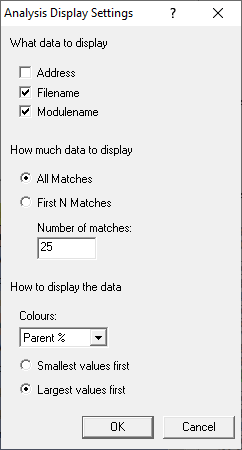
Sorting the data
The result tree is initially ordered by most time consuming function first (Total Time)
•Smallest values first  change the ordering direction of the data
change the ordering direction of the data
•Largest values first  change the ordering direction of the data
change the ordering direction of the data
 Note that while your application is executing, the sorted data is live. Sorting may not complete correctly as the data may change during the sort. Only when your program has finished executing is the sorted data guaranteed accurate.
Note that while your application is executing, the sorted data is live. Sorting may not complete correctly as the data may change during the sort. Only when your program has finished executing is the sorted data guaranteed accurate.
Managing the data being displayed
You can't filter out functions by name but there are two ways to change what's displayed in the view.
Change the amount of detail shown for each function:
•Address  check to show the address in memory for the function
check to show the address in memory for the function
•Filename  check to show the file location in which the function was found
check to show the file location in which the function was found
•Modulename  shows the function's module
shows the function's module
Reduce the scope of the tree by only showing a partial list of results:
•First N Matches  restricts the results to a specified number of matches
restricts the results to a specified number of matches
•All Matches  shows all results
shows all results
 You'll need to Search again in order to update the display
You'll need to Search again in order to update the display
Finding text
To find text in the tree, use the Find Dialog where you can search for functions, files and modules.
 The source code view has its own Find and Goto dialogs.
The source code view has its own Find and Goto dialogs.
Analysis results menu options
The following popup menu is available over the result tree to add filters, examine relations or edit code.
Menu actions apply to the function in the tree at the menu-click location.
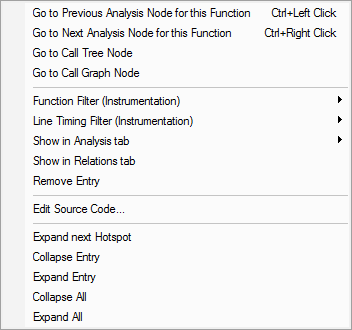
 Menu options: Previous and next result nodes
Menu options: Previous and next result nodes
Functions may appear in the tree more than once if called by different parent functions.
•Go to Previous Analysis Node for this Function  jump to the previous instance of this function in any of the result trees
jump to the previous instance of this function in any of the result trees
 +
+ has the same action
has the same action
•Go to Next Analysis Node for this Function  jump to the next instance of this function in the results
jump to the next instance of this function in the results
 +
+ has the same action
has the same action
If there are no previous or next instances, nothing will happen.
 Menu options: Show in other tabs
Menu options: Show in other tabs
•Go to Call Graph Node  switch to the Call Graph view where the display will be expanded to show the first match found for the selected function
switch to the Call Graph view where the display will be expanded to show the first match found for the selected function
 Menu options: Go to Call Tree or Graph
Menu options: Go to Call Tree or Graph
•Go to Call Tree Node  switch to the Call Tree view where the display will be expanded to show the first match found for the selected function
switch to the Call Tree view where the display will be expanded to show the first match found for the selected function
•Go to Call Graph Node  open the Call Graph view at the main entry for the selected function
open the Call Graph view at the main entry for the selected function
The Call Graph view is similar to the Call Tree, but where a function would appear multiple times, it instead appears once as the main instance and is then linked to from other locations.
 Menu options: Function filter (Instrumentation)
Menu options: Function filter (Instrumentation)
While the display filter controls visibility of hooked data, instrumentation filters control which functions are hooked in the first place.
The function instrumentation filter sub-menu lets you add hook filters at different levels of granularity.
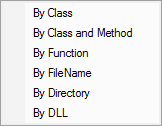
 The affect of adding function filters here depends on the current filter settings:
The affect of adding function filters here depends on the current filter settings:
•If the current filters are set to hook everything, adding new filters will switch to excluding newly selected hooks
•Otherwise, the current filter will be retained, i.e. hook or don't hook newly selected items
The first three options add filters to the Class and Function Filter Settings:
•By Class  adds a new filter, excluding the entire class from the results of subsequent sessions
adds a new filter, excluding the entire class from the results of subsequent sessions
•By Class and Method  excludes only the selected function from new sessions
excludes only the selected function from new sessions
•By Function  excludes all matching function names irrespective of their containing class or even if not in a class at all
excludes all matching function names irrespective of their containing class or even if not in a class at all
The next two, Filename and Directory, are part of the Source Files Filter settings.
•By FileName  adds a new filter, excluding all functions in the same file (as the selected item) from the results of subsequent sessions
adds a new filter, excluding all functions in the same file (as the selected item) from the results of subsequent sessions
•By Directory  excludes functions in all files in the same directory as the selected function
excludes functions in all files in the same directory as the selected function
Finally, the DLL level is controlled by the Hooked DLLs settings.
•By DLL  excludes functions in all files belonging to the same executable or DLL as the selected function
excludes functions in all files belonging to the same executable or DLL as the selected function
 Instrumentation filters become effective at the start of the next session. Adding a filter during a session will show the relevant rows in grey so that you can see which files would be filtered, but the performance data will continue to be included for the rest of the current session.
Instrumentation filters become effective at the start of the next session. Adding a filter during a session will show the relevant rows in grey so that you can see which files would be filtered, but the performance data will continue to be included for the rest of the current session.
 Menu options: Line timing filter (Instrumentation)
Menu options: Line timing filter (Instrumentation)
Line timing instrumentation filters control which lines are hooked for line timing and are independent of the function filters above.
 The affect of adding line timing filters here depends on the current line timing filter settings:
The affect of adding line timing filters here depends on the current line timing filter settings:
•If the current filters are set to hook everything, adding new filters will switch to only including newly selected hooks
Note that this is the opposite of function filters.
•Otherwise, the current filter will be retained, i.e. hook or don't hook newly selected items
The line timing instrumentation filter sub-menu lets you add hook filters at three different levels of granularity.
Each option add filters to the Line Timing Filter Settings:
•By Class  adds a new filter, appending the entire class in the line timing results of subsequent sessions
adds a new filter, appending the entire class in the line timing results of subsequent sessions
•By Class and Method  include only the selected function in the line timing of new sessions
include only the selected function in the line timing of new sessions
•By Function  includes all matching function names irrespective of their containing class or even if not in a class at all
includes all matching function names irrespective of their containing class or even if not in a class at all
 Instrumentation filters become effective at the start of the next session. Adding a filter during a session will show the relevant rows in grey so that you can see which files would be filtered, but the performance data will continue to be included for the rest of the current session.
Instrumentation filters become effective at the start of the next session. Adding a filter during a session will show the relevant rows in grey so that you can see which files would be filtered, but the performance data will continue to be included for the rest of the current session.
 Menu option: Show in Analysis tab
Menu option: Show in Analysis tab
While this may already be the Analysis tab, sometimes it can be useful to choose a function from the results and pivot the search to show a new result set:
•Show in Analysis tab  choosing any item in the following sub-menu, to perform a new search in the Analysis tab
choosing any item in the following sub-menu, to perform a new search in the Analysis tab
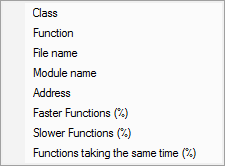
For example:
•Class  the results show all points in the call tree that match the class of the selected function
the results show all points in the call tree that match the class of the selected function
•File name  shows all points in the call tree that match the file name of the selected function
shows all points in the call tree that match the file name of the selected function
•Slower Functions (%)  shows all functions that are slower than the selected function
shows all functions that are slower than the selected function
 Menu options: Show in Relations tabs
Menu options: Show in Relations tabs
•Show in Relations tab  switch to the Relations tab where you can examine functions that either call, or are called by, the selected function
switch to the Relations tab where you can examine functions that either call, or are called by, the selected function
Double clicking any item will also display it in the Relations tab.
 Menu options: Remove entry
Menu options: Remove entry
You can hide some entries from the displayed results.
However, this is a very temporary action, as a function and its children will only be hidden from view until the next Search.
•Remove entry  hides the selected function in the tree
hides the selected function in the tree
Only the selected node is hidden. Other calls to the same function in a different part of the results will remain.
 Menu option: editing source code
Menu option: editing source code
•Edit Source Code...  opens the default or preferred editor to edit the source code
opens the default or preferred editor to edit the source code
 Menu options: Expand and collapse
Menu options: Expand and collapse
The last few menu options expand and collapse parts of the tree.
•Expand Next Hotspot  finds the next most significant in the call tree and expands all the callstack nodes to make it visible
finds the next most significant in the call tree and expands all the callstack nodes to make it visible
•Collapse / Expand Entry  close or recursively open the selected function to its full extent
close or recursively open the selected function to its full extent
•Collapse / Expand All  completely collapse or expand the entire tree
completely collapse or expand the entire tree
The file source code view
Clicking on a function in the results tree shows that function's source code file in the right hand pane.
The source code view is described in detail separately as its behaviour is the same for all views.
